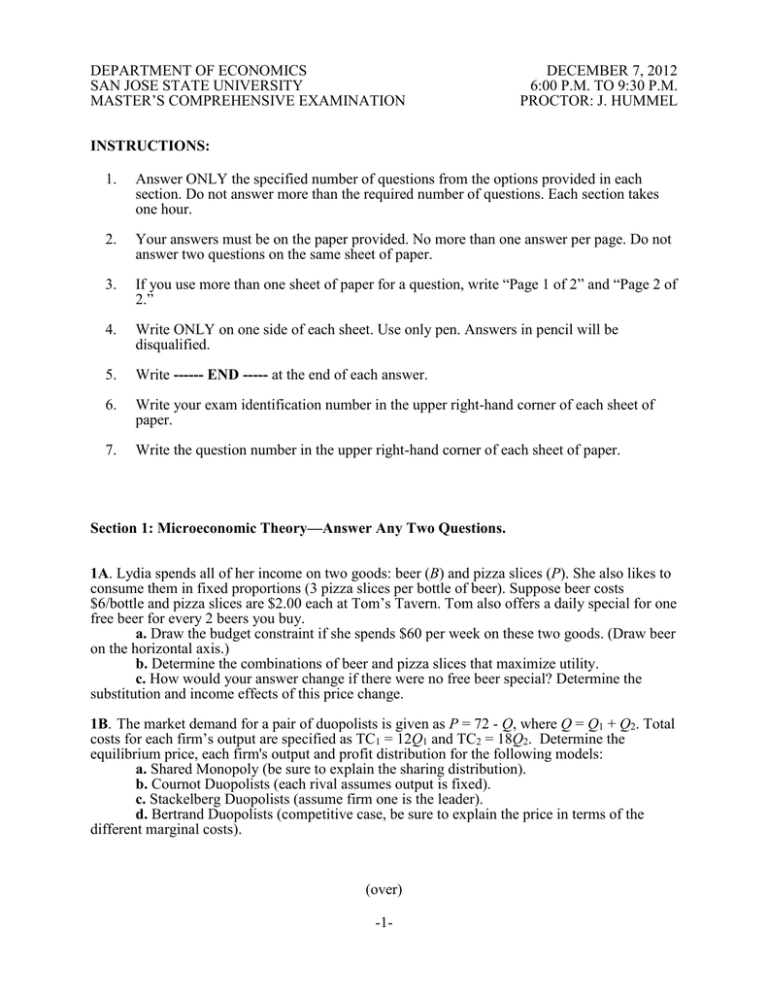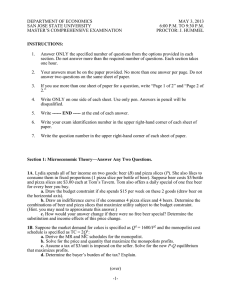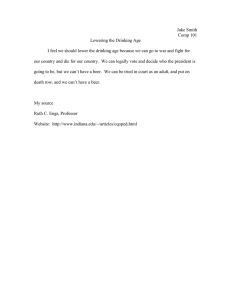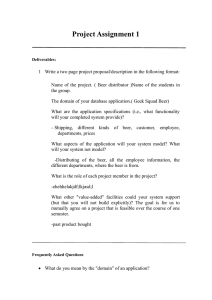DEPARTMENT OF ECONOMICS DECEMBER 7, 2012 SAN JOSE STATE UNIVERSITY
advertisement

DEPARTMENT OF ECONOMICS SAN JOSE STATE UNIVERSITY MASTER’S COMPREHENSIVE EXAMINATION DECEMBER 7, 2012 6:00 P.M. TO 9:30 P.M. PROCTOR: J. HUMMEL INSTRUCTIONS: 1. Answer ONLY the specified number of questions from the options provided in each section. Do not answer more than the required number of questions. Each section takes one hour. 2. Your answers must be on the paper provided. No more than one answer per page. Do not answer two questions on the same sheet of paper. 3. If you use more than one sheet of paper for a question, write “Page 1 of 2” and “Page 2 of 2.” 4. Write ONLY on one side of each sheet. Use only pen. Answers in pencil will be disqualified. 5. Write ------ END ----- at the end of each answer. 6. Write your exam identification number in the upper right-hand corner of each sheet of paper. 7. Write the question number in the upper right-hand corner of each sheet of paper. Section 1: Microeconomic Theory—Answer Any Two Questions. 1A. Lydia spends all of her income on two goods: beer (B) and pizza slices (P). She also likes to consume them in fixed proportions (3 pizza slices per bottle of beer). Suppose beer costs $6/bottle and pizza slices are $2.00 each at Tom’s Tavern. Tom also offers a daily special for one free beer for every 2 beers you buy. a. Draw the budget constraint if she spends $60 per week on these two goods. (Draw beer on the horizontal axis.) b. Determine the combinations of beer and pizza slices that maximize utility. c. How would your answer change if there were no free beer special? Determine the substitution and income effects of this price change. 1B. The market demand for a pair of duopolists is given as P = 72 - Q, where Q = Q1 + Q2. Total costs for each firm’s output are specified as TC1 = 12Q1 and TC2 = 18Q2. Determine the equilibrium price, each firm's output and profit distribution for the following models: a. Shared Monopoly (be sure to explain the sharing distribution). b. Cournot Duopolists (each rival assumes output is fixed). c. Stackelberg Duopolists (assume firm one is the leader). d. Bertrand Duopolists (competitive case, be sure to explain the price in terms of the different marginal costs). (over) -1- DEPARTMENT OF ECONOMICS SAN JOSE STATE UNIVERSITY MASTER’S COMPREHENSIVE EXAMINATION DECEMBER 7, 2012 6:00 P.M. TO 9:30 P.M. PROCTOR: J. HUMMEL 1C. Given a production function Q = f (K, L) = K0.5L0.5: a. Derive the marginal product of capital and the marginal product of labor. b. Derive the second order partial derivatives fKK, fLL, and use their signs to explain whether the Law of Diminishing Returns prevails in the use of capital and labor. c. Derive the second order partial derivative fKL and use its sign to explain how capital and labor are related (substitutes or complementary to each other). -2-


